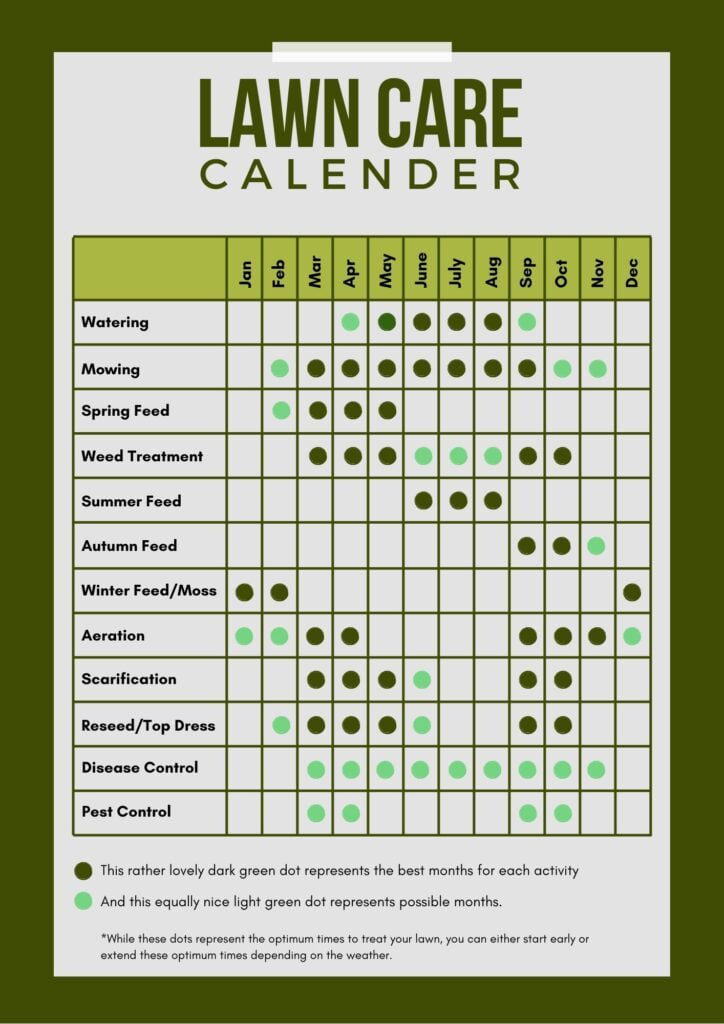The Expert’s Guide To Treating Your Lawn All-Year Round
There are 4 things you cannot get back in life: the word after it’s said, the moment after it’s missed, time after it’s gone and a lawn after you’ve forgotten to treat it properly. The problem with the last one is, there’s no one-rule for how to treat your lawn because, well, every lawn is ever-so-slightly unique.
That’s why we have to be a little cautious whenever one of our clients asks us how often they should treat their lawn because it all depends on their lawn and certain factors. There’s knowing the current condition of a lawn, what pH level of the soil is beneath it, what grass species is used in the lawn, how much sunlight and shade it is exposed to, the client’s mowing regime and how much wear and tear it gets from pets, children or just the homeowners footfall. That’s why we prefer to come and assess each lawn with our own expert eyes.
That said, to get a good looking lawn (one that will make all your neighbours green with envy), there are 7 fundamental lawn care treatments that we suggest performing each and every year, and they are:
- Apply a spring fertiliser
- Eliminate weeds
- Apply a summer fertiliser
- Aerate your lawn
- Apply an autumn fertiliser
- Scarify your lawn
- Apply a moss control

Your Spring Treatments
Improving your lawn can start at any time of the year, but the best lawns almost-always start in spring, as the soil warms up, the days start getting longer and your grass begins springing into growth mode. And because the winter rains will have washed most of the vital nutrients out of the soil, we recommend kickstarting your lawn care treatment plan with a spot of fertiliser in either granule or liquid form.
By doing this in the spring, you’ll give your grass a bit of motivation to start growing nice and lush, especially if you use a high-in-nitrogen feed. Just make sure it’s a slow release fertiliser so that it won’t wash away at the first sight of rain. And with that done, your lawn will be on the highway to controlled and balanced growth, and strong enough to crowd out any emerging weeds. Next stop: lush-green-grass-ville.

Your Summer Treatments
To get straight into it: From May until July, your lawn is going to grow-up faster than your children. As such, your early-summer lawn care should be focussed on 2 things: watering your lawn and mowing it both correctly and regularly. By doing this, you won’t just be keeping it tidy, you’ll be encouraging the growth of side shoots, which is what gives the sward a lovely, velvety texture, while also helping it a) cope with all the extra stress and wear that comes with summer usage and b) protects your soil from drying out.
As for feeding, your best bet is to apply liquid feeds alongside wetting agents, which is a product that helps water penetrate into the soil when the conditions have become dry. Oh and, on the disease front, keep a look out for red thread, which has a knack for attacking any patch of grass that’s under extra stress from heat or drought.

Your Autumn Treatments
Now we don’t want to say any one season is more important than the next, but autumn is the most important period in the entire lawn care calendar. This is because winter’s can be super-harsh on your lawn. But if you leave your turf in a good way come the autumn, it will thank you big time in spring. We’re talking lush, green grass. Neglect your autumn duties and your lawn will struggle to live its best life the next year.
The trick is going into those hardcore winter months with a “dry” lawn, which means doing three things: aeration, aeration and a bit more aeration.
Aeration means making holes in your lawn to let your roots breath and your grass and soil thrive from all those extra nutrients. Think of it as an annual spa treatment for your lawn, normally done at the start of autumn (September/October) when the ground is nice and soft — and preferably after a nice, thatch-clearing lawn scarification job.
Lawn scarification is like dragging a rake across your lawn to remove the layer of thatch and dead moss that’s built up in your lawn, except we use a mechanical machine that kicks thatch butt. Of course, battling years worth of build-up and decline is still a labour intensive job, but it’s so important. No, it’s utterly essential.
Autumn fertiliser:
You want to use that low in Nitrogen but high in potash and phosphates fertiliser to harden your lawn for Winter and encourage good root growth.
After performing these three treatments, the best thing you can give your lawn is a generous sprinkling of top dressing (sand/soil mixture) followed by some extra grass seed to help thicken and improve the quality of your lawn. The reason for a topdressing is to give your lawn a healthy soil base without harming any of your existing turf.
The other reason for using a top dressing is to improve those uneven patches of lawn by filling in any dips and hollows — and because you’ve already aerated your lawn like a legend, the dressing will fill the plug holes and keep them open for longer. Voila, better drainage, stronger roots and way more resilient lawn. After this, throw some over-seed on any bare areas caused by a nasty moss invasion or just your normal wear and tear.

Thanks for reading the expert’s guide to treating your lawn all-year round! For more lawn care tips and tricks, follow us on Facebook and Instagram.





